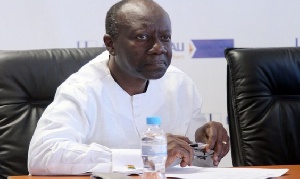Ghana's economy is expected to grow by 6.3 per cent in 2017, compared to 3.8 per cent growth rate realised in 2016, ratings agency Fitch’s subsidiary BMI has affirmed.
According to BMI, “while this represents a moderate downgrade to our 2017 forecast, from 6.5 percent previously in the wake of revelations of a hole in the country's finances and delays to major oil projects, this expansion will nevertheless mark a recovery in Ghana from its recent years of macroeconomic turmoil. This would be the strongest growth rate since 2013”, it stated.
Continuing it said “oil production growth will be a major economic driver for Ghana, though recent developments in the sector have encouraged us to modestly temper our near-term crude output forecasts.”
Following estimated growth of 26.1 percent in oil production in 2016, BMI's Oil & Gas team forecasts further increases of 15.2 percent in 2017 and 26.6 percent in 2018. These growth projections it said are slightly revised from last quarter, when it projected 40 percent in 2017 and 10.0 percent in 2018.
It added that it expect output from the Tweneboa, Enyenra, Ntomme (TEN) fields to be around 55,000 barrels per day in 2017 as production ramps up from first oil in August 2016, though this is lower than it initially predicted and below the total production potential of the project (80,000b barrels per day).
“Our recent downward revisions have come primarily due to Tullow's issues managing well pressure at the Enyenra reservoir. Moreover, due to an ongoing maritime border dispute with neighbouring Cote d'Ivoire, no new wells will be able to be drilled until Q417 at the earliest, preventing a proper solution to the problems at the Enyenra field.”
It also noted that gold mining looks positive adding “Oil and gas is not the only extractive industry we expect to drive growth in Ghana in 2017 and 2018, as the country's gold mining sector received a welcome boost following the announcement in January 2017 by Golden Star Resources Ltd. that commercial production has begun at the Wassa Underground Gold Mine.”
Golden Star Resources’ Wassa mine - which comprised of a main pit and an underground pit - has proven Mineral Reserves of 1.5 million ounces. It is estimated that this year's production at the entire mine will amount to 145-160,000 oounces, of which 60,000 ounces will come from the newly producing underground mine. The company expects another of its projects to come online in mid-2017, further contributing to growth.
Brighter outlook beyond near term
BMI explained that going forward, the increase in oil production will also boost real GDP growth in Ghana through curbing imports, as greater levels of feedstock will enable the country to refine more of its own fuels.
Furthermore, it noted that the proliferation of gas supply, notably from the Offshore Cape Three Points OCTP project from 2018, will support Ghana's thermal power generation schemes. The availability of domestic feedstock will prop up the country's efforts to reduce overreliance on hydropower in the energy supply; the intermittency of which is a source of outages and ongoing disruption in the country, it opined.
According to the Ghana National Petroleum Company, the OCTP project could supply 1.1-1.3 GW of new power plants, effectively increasing the country's electricity supply by 50 per cent.
For investor confidence in Ghana, BMI said the IMF remains apparently positive towards the country, and it does not expect that it will fail its review in March 2017.
Nevertheless, with debt levels at 74.0 percent of GDP at end-2016 as a result of this hidden spending, investor confidence will have taken a hit, it added.
“Should the country be downgraded by major ratings agencies as a result of the higher debt levels, it would push up the cost of international borrowing for the government. As a result, it would continue to rely on considerable domestic borrowing, crowding out the private sector and constraining the growth of small- and medium-sized enterprises.”
Business News of Thursday, 16 March 2017
Source: thefinderonline.com

















